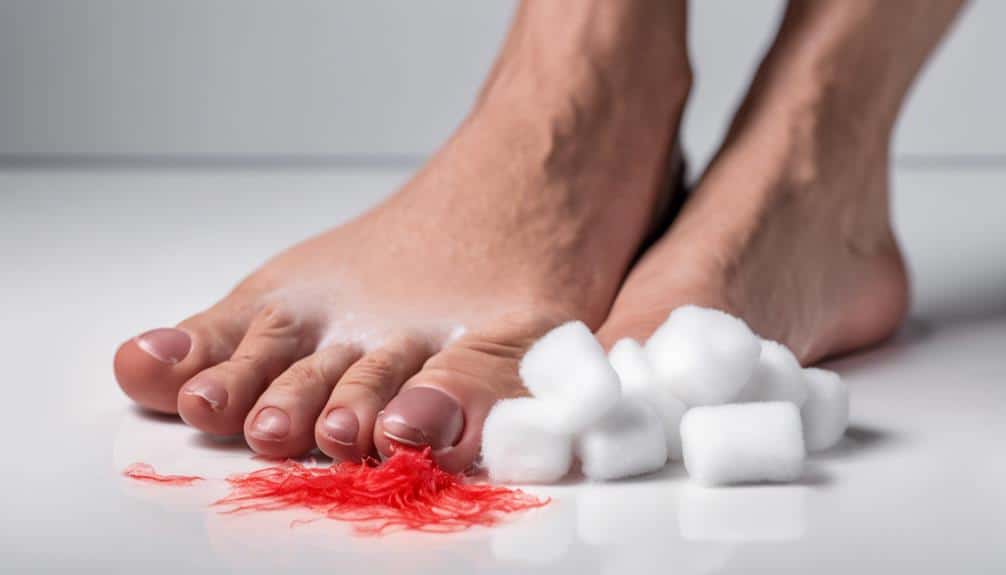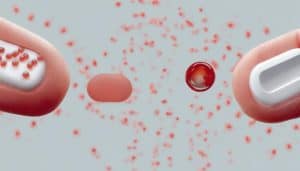To alleviate the discomfort of an ingrown toenail overnight, soak your foot in warm, soapy water with Epsom salts or apple cider vinegar to reduce pain and swelling. Next, gently lift the nail edge using a clean cotton ball or dental floss to relieve pressure. Apply antiseptic ointment to promote healing and prevent infection. Protect your toe with toe caps, bandages, or toe shields to reduce friction and rubbing. Finally, explore additional pain relief options like cold compresses, elevation, and over-the-counter pain relievers. Continue with these steps to set yourself on the path to recovery and explore further for a thorough solution.
Key Takeaways
• Soak your foot in warm, soapy water with Epsom salts or apple cider vinegar to reduce pain, swelling, and infection risk.
• Gently lift the nail edge with a clean cotton ball or dental floss to relieve pressure and promote healing.
• Apply antiseptic ointment like neomycin or mupirocin after soaking to prevent infection and promote healing.
• Protect the toe with toe caps, bandages, or toe shields to reduce friction and rubbing while you sleep.
• Elevate your foot overnight and consider using pain relief options like cold compresses or over-the-counter pain relievers for added comfort.
Soaking for Relief
What's the most effective way to alleviate the discomfort of an ingrown toenail, and can a simple soak really make a difference?
The answer lies in the power of soaking. Soaking your affected toe in warm, soapy water can help reduce pain and swelling associated with an ingrown toenail.
But that's not all – adding Epsom salts to the foot soak can provide additional relief and promote healing overnight. The magnesium in Epsom salts helps to reduce inflammation and improve circulation, making it an ideal ingredient for ingrown toenail relief.
For an extra boost, try soaking your ingrown toenail in apple cider vinegar diluted with water. The acidity in the vinegar helps to reduce inflammation and prevent infection, creating an environment that's conducive to healing. Just be sure to dry your foot thoroughly after soaking to prevent moisture-related complications overnight.
Lifting the Nail Edge
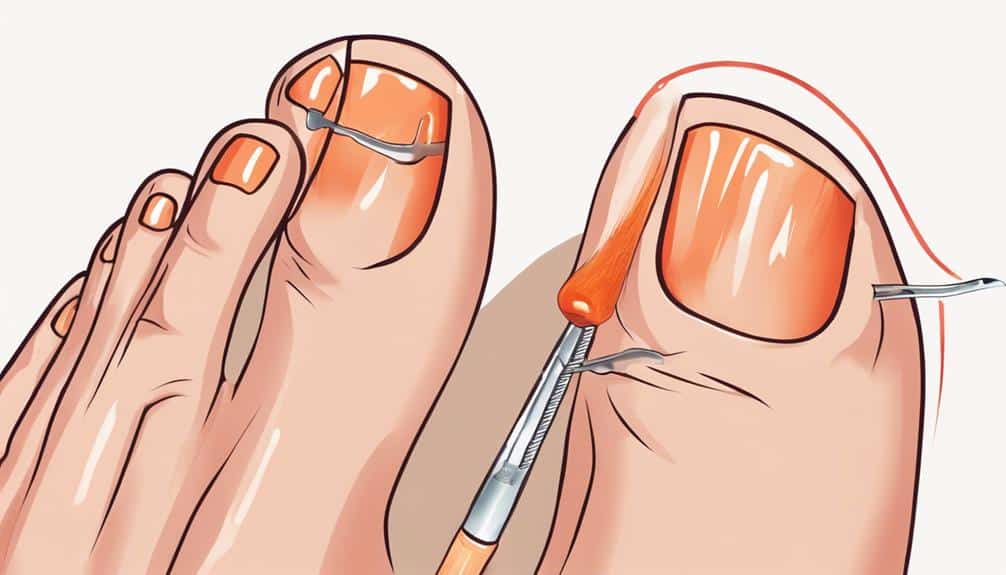
After soaking your ingrown toenail, you can further alleviate pressure and pain by gently lifting the edge of the nail. This technique can provide temporary relief and help reduce discomfort overnight.
To lift the nail edge, use a clean cotton ball or dental floss to carefully pry the nail away from the skin. Be cautious not to cause further damage or pain while doing so.
Here are some important considerations to keep in mind:
- Use a clean cotton ball or dental floss to gently lift the edge of the ingrown toenail.
- Lifting the nail edge can help reduce pressure and pain overnight, but it may not completely resolve the issue.
- Be cautious not to cause further damage or pain while lifting the nail edge.
- If the ingrown toenail persists or worsens, seek professional treatment for proper care and removal.
Applying Antiseptic Ointment
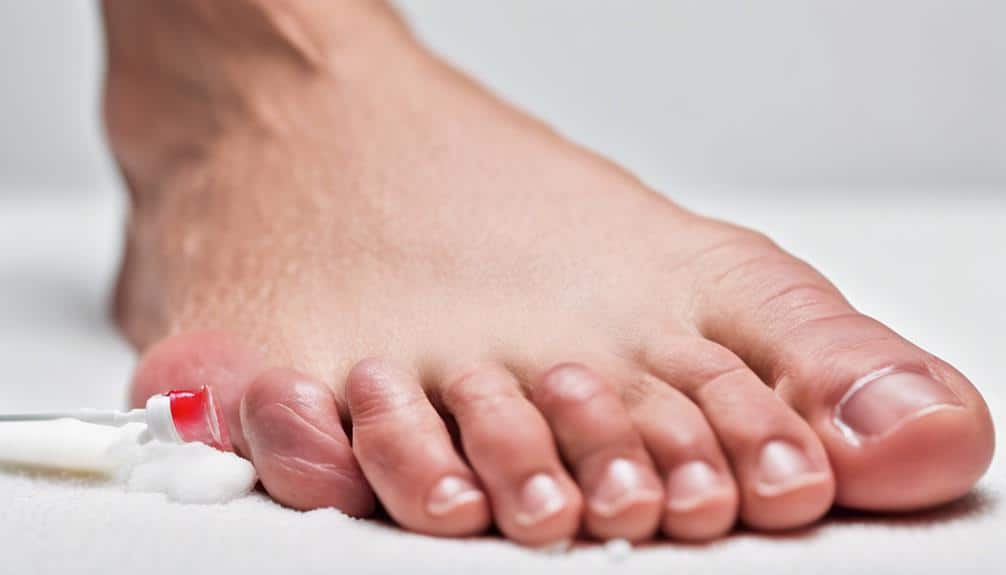
To promote healing and prevent infection, apply a thin layer of antiseptic ointment, such as neomycin or mupirocin, to the affected area after soaking the ingrown toenail. This important step helps create an environment conducive to recovery.
Antiseptic ointments are specifically designed to prevent infection and promote healing, making them a vital tool in your overnight ingrown toenail removal journey.
When applying the antiseptic ointment, be sure to follow the instructions on the packaging for proper application and frequency. You don't want to over- or under-apply the ointment, as this could hinder the healing process. By following the instructions, you'll be able to enjoy the benefits of consistent application, which can help reduce pain and swelling associated with ingrown toenails overnight.
After applying the antiseptic ointment, lightly bandage the toe to protect the area while you sleep. This will help keep the area clean and prevent any further irritation.
Protecting the Toe
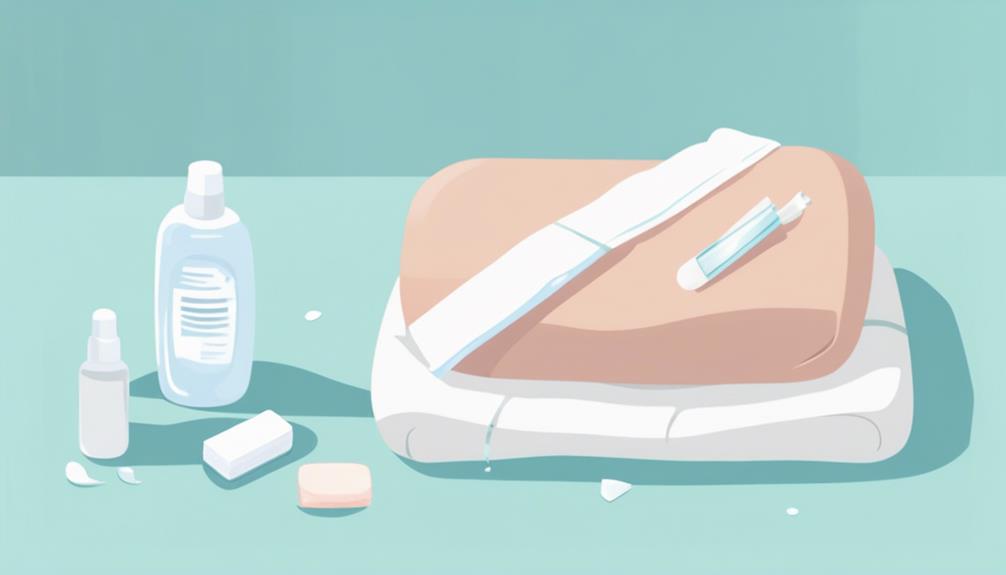
Continuing your treatment for the ingrown toenail, it's crucial to protect the affected toe from further irritation and infection.
You'll want to shield your toe from friction and pressure by using protective toe caps or bandages and take steps to keep the area clean and dry.
Toe Shielding Techniques
You can utilize toe shields to safeguard your ingrown toenail from further irritation and pressure overnight, allowing for a more comfortable and restful sleep. These shields provide cushioning and protection, reducing friction and rubbing on the affected area, promoting healing and relieving discomfort.
When using toe shields, consider the following benefits:
- Soft gel or silicone materials provide comfort and cushioning for your ingrown toenail.
- Reduced friction and rubbing minimize further irritation, allowing your toe to heal faster.
- Customizable fit guarantees a snug and secure fit, providing excellent protection and support.
- Overnight relief allows you to wake up feeling more comfortable, with decreased pain and swelling.
Preventing Further Irritation
By taking proactive measures to protect your toe, you can prevent further irritation and promote a speedy recovery from an ingrown toenail. To avoid exacerbating the pain and potential infection, ditch the tight shoes and opt for open-toed sandals or shoes that provide ample room for your foot to breathe. This will reduce pressure on the affected area, allowing it to heal faster.
Consider investing in a toe protector or cushion designed specifically for ingrown toenails. These innovative solutions provide extra padding, preventing friction and discomfort. Additionally, keep the affected toe clean and dry to minimize the risk of infection.
To take it a step further, consider using a non-medicated toe brace to gently lift the toenail and relieve pressure on the ingrown area while you sleep. By taking these proactive measures, you can protect your toe, reduce pain, and promote a speedy recovery from an ingrown toenail.
Pain Relief Options

To help manage the discomfort associated with an ingrown toenail, several pain relief options are available to provide overnight comfort and relief. While addressing the underlying issue is crucial, finding immediate relief from the pain and discomfort can greatly enhance your quality of life.
Here are some pain relief options you can consider:
- Apply a cold compress to the affected area to reduce pain and inflammation overnight.
- Elevate your affected foot while sleeping to alleviate throbbing and discomfort.
- Take over-the-counter pain relievers like acetaminophen or ibuprofen to provide temporary relief from ingrown toenail pain overnight.
- Use numbing sprays or gels specifically designed for foot pain to numb the area and provide overnight comfort.
In severe cases, it's best to consult a podiatrist, who may prescribe stronger pain medication for immediate relief from an ingrown toenail overnight.
Preventing Further Irritation
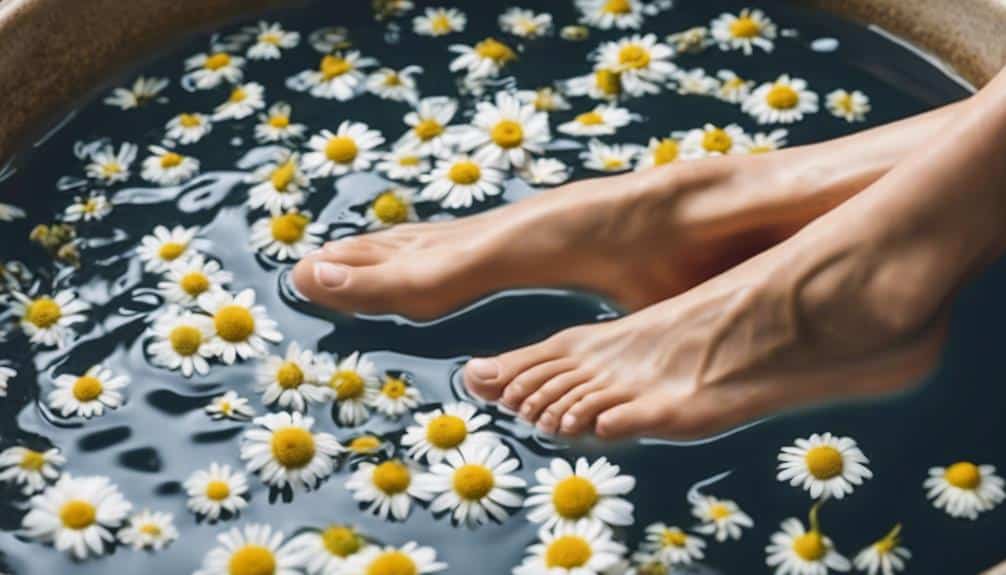
To prevent further irritation, you'll want to soften the skin around the ingrown toenail. Reduce inflammation quickly and wear comfortable shoes that don't exacerbate the issue. By taking these steps, you'll be able to minimize discomfort and promote healing.
Soften the Skin
Soaking your affected toe in warm soapy water or Epsom salt can help soften the skin around the ingrown toenail, reducing further irritation. This gentle treatment makes it easier to gently lift the edge of the ingrown nail and provide temporary relief. Remember to avoid cutting or digging into the skin aggressively, as this can lead to more pain and potential infection.
To soften the skin effectively:
- Soak your toe in warm soapy water or Epsom salt for 15-20 minutes
- Apply a small amount of antibiotic ointment to protect against infection overnight
- Cover the ingrown toenail with a bandage or gauze for additional protection
- Avoid cutting or digging into the skin aggressively to prevent further irritation
Reduce Inflammation Fast
By applying a cold compress to the affected area, you can quickly reduce inflammation and relieve pain associated with an ingrown toenail. This simple yet effective technique helps constrict blood vessels, reducing swelling and promoting drainage.
Additionally, elevate your foot to reduce swelling and promote drainage, aiding in overnight relief.
To further prevent further irritation, avoid putting pressure on the affected toe by wearing open-toed shoes or sandals. You can also use anti-inflammatory creams or ointments containing ingredients like hydrocortisone or tea tree oil to soothe the area. These topical treatments can help reduce inflammation and discomfort, making it easier to manage your symptoms overnight.
If you're experiencing significant discomfort, consider taking over-the-counter pain relievers like ibuprofen to help manage inflammation and discomfort.
Wear Comfortable Shoes
When managing an ingrown toenail, you'll want to prioritize footwear that prioritizes comfort and breathability, as the right shoes can make a substantial difference in preventing further irritation and promoting overnight recovery. Wearing comfortable shoes can greatly reduce discomfort and prevent further irritation, allowing your ingrown toenail to heal faster at home.
Here are some tips to keep in mind when selecting the right shoes:
- Opt for open-toed or wide shoes to reduce pressure on the ingrown toenail and prevent further irritation.
- Avoid wearing tight or narrow shoes that can worsen the ingrown toenail condition overnight.
- Choose footwear with soft, cushioned soles to provide comfort and reduce friction on the affected toe.
- Make sure there's enough space in the toe box of the shoes to allow the toenail to heal properly overnight.
Causes of Ingrown Toenails
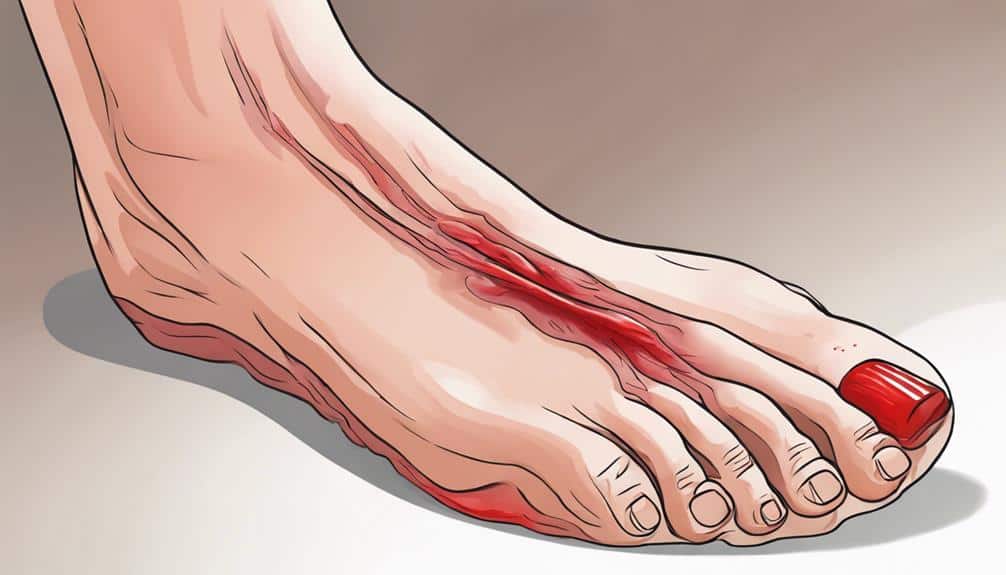
Improper nail trimming techniques, which you may unwittingly use, are a leading cause of ingrown toenails. When you cut your toenails too short or cut the corners, it can lead to the nail growing into the skin, causing pain and discomfort.
However, improper trimming is not the only cause of ingrown toenails. Other factors can contribute to their development, including:
| Cause | Description | Prevention |
|---|---|---|
| Improper Trimming | Cutting nails too short or at an angle | Trim nails straight across, avoiding cutting corners |
| Tight Shoes | Shoes that are too small or narrow can cause pressure | Wear shoes with a roomy toe box |
| Trauma or Injury | Dropping something on your toe or stubbing it | Take precautions to avoid accidents |
| Genetics | Natural shape of the nail can increase risk | Practice good foot hygiene and trimming techniques |
| Poor Foot Hygiene | Fungal infections and bacteria can increase risk | Wash feet daily, dry thoroughly, and trim nails properly |
Additionally, poor foot hygiene and fungal infections can increase the risk of developing ingrown toenails. By understanding the causes of ingrown toenails, you can take preventative measures to avoid getting them in the first place. Proper nail trimming, wearing comfortable shoes, and practicing good foot hygiene can go a long way in reducing your risk.
Home Remedies for Relief

As you explore home remedies for relief from an ingrown toenail, you'll find that soaking and softening the area can make a significant difference.
By incorporating natural antiseptics into your routine, you can promote healing and reduce the risk of infection.
In the following section, we'll discuss specific techniques and ingredients you can use to soothe and treat your ingrown toenail.
Soak and Soften
To alleviate discomfort and promote healing, try soaking your affected toe in warm, soapy water, a simple yet effective remedy that can soften the skin around the ingrown toenail overnight. This soaking process can help reduce swelling and ease pain, making it an ideal first step in treating your ingrown toenail.
Some additional soaking options you can try include:
- Adding Epsom salts to the foot soak to provide additional relief and reduce inflammation
- Soaking the ingrown toenail in apple cider vinegar diluted in water to help alleviate discomfort and promote healing
- Softening the toenail by soaking it, making it easier to gently lift or trim the nail to reduce pressure and pain
- Consistently soaking and softening your toe nightly to gradually improve the ingrown toenail condition over time
Natural Antiseptics
Your ingrown toenail can benefit from natural antiseptics, which offer a gentle yet effective way to promote healing and prevent infection. Soaking your foot in warm water with Epsom salt or apple cider vinegar can help reduce inflammation and pain overnight. This simple remedy can provide instant relief and create an environment conducive to healing.
To take it a step further, apply antibiotic ointment or petrolatum jelly to the affected area before bed. This won't only promote healing but also prevent infection, ensuring you wake up to improved symptoms. Additionally, using toe protectors or cushioning pads can provide relief and protection while sleeping, reducing pressure on the ingrown toenail.
By incorporating these natural antiseptics into your overnight routine, you can expect significant improvement in your condition by morning. Remember to elevate your affected foot overnight to reduce swelling and discomfort.
When to Seek Medical Help
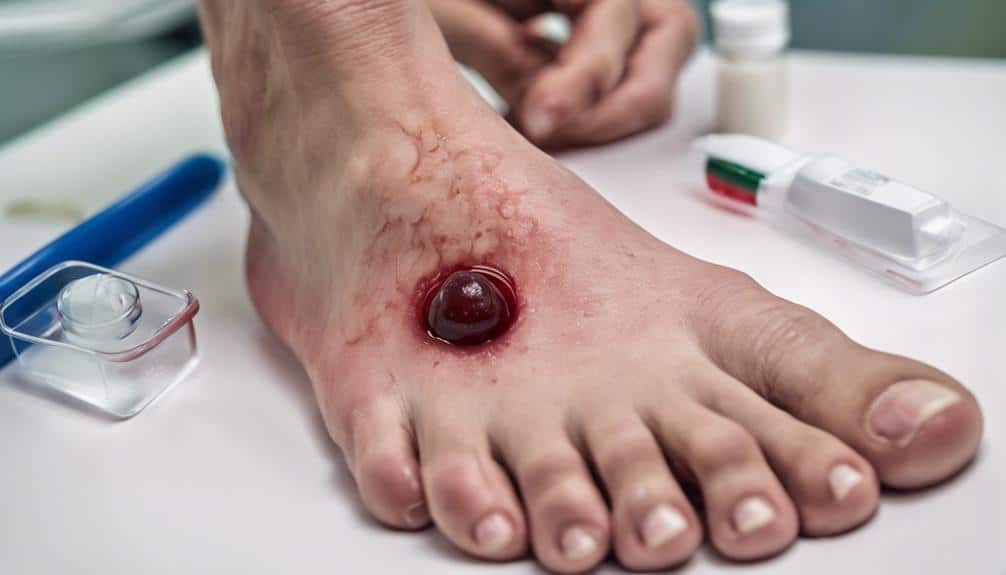
If you're experiencing severe pain or notice signs of infection, such as redness, warmth, or pus, don't hesitate to seek medical help immediately. An infected ingrown toenail can quickly worsen if left untreated, leading to more severe infections and potential long-term damage.
It's crucial to recognize the signs of infection and take prompt action. A severely infected ingrown toenail requires professional intervention for safe and effective removal. A podiatrist can provide proper treatment and prevent complications from worsening.
Here are some scenarios that warrant immediate medical help:
- You experience severe pain that interferes with your daily activities
- You notice signs of infection, such as redness, warmth, or pus, around the ingrown toenail
- You have a weakened immune system, making you more susceptible to infection
- You've tried home remedies, but the ingrown toenail persists or worsens
Don't wait to seek medical help, as delays can lead to more severe infections and potential long-term damage. By recognizing the signs of infection and taking prompt action, you can prevent complications and ensure proper treatment for your ingrown toenail.
Preventing Future Occurrences
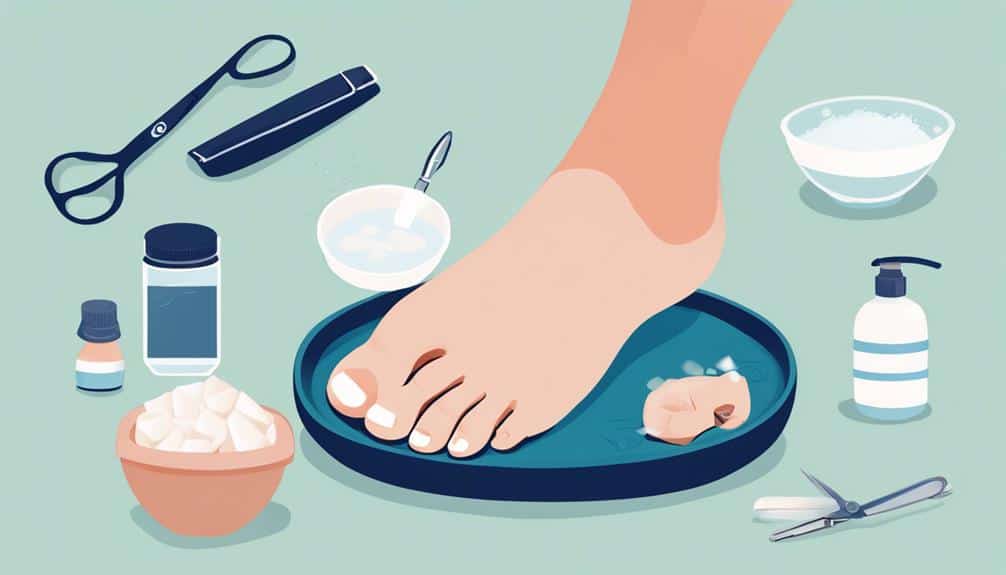
By taking proactive steps to modify your nail care routine and shoe choices, you can greatly reduce the risk of ingrown toenails recurring in the future. To prevent future occurrences, it is crucial to trim your toenails straight across, avoiding cutting them too short or at an angle. This simple technique can notably decrease the likelihood of ingrown toenails.
| Prevention Method | Description | Benefits |
|---|---|---|
| Trim toenails straight | Trim toenails straight across to prevent ingrown toenails | Reduces risk of ingrown toenails |
| Wear properly fitted shoes | Wear shoes that fit comfortably, avoiding pressure on toes | Minimizes risk of ingrown nails |
| Practice good foot hygiene | Clean and dry toes regularly to prevent infections | Reduces risk of infection |
| Avoid cutting nails too short | Avoid cutting toenails too short to prevent ingrown toenails | Decreases likelihood of ingrown toenails |
| Seek professional advice | Consult a podiatrist for personalized prevention advice | Provides tailored guidance for preventing ingrown toenails |
Overnight Ingrown Toenail Care
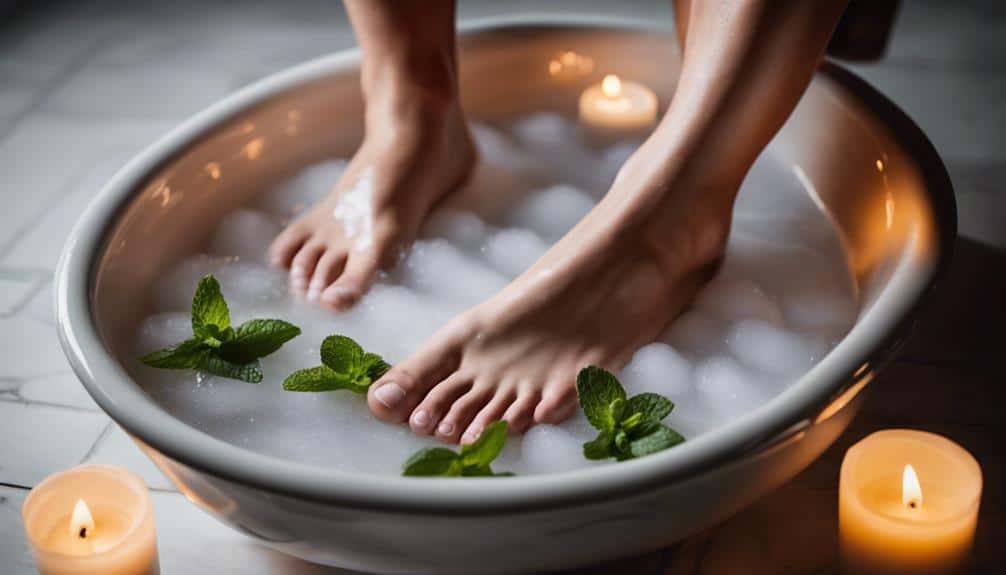
Proper overnight care is essential for alleviating the discomfort and promoting healing of an ingrown toenail, and involves a combination of soaking, topical treatments, and careful bandaging.
To effectively care for your ingrown toenail overnight, start by soaking your foot in a basin of warm water at home. This will help reduce pain and swelling.
Next, apply an antibiotic ointment to the ingrown toenail before bed to prevent infection and promote healing. Gently lifting the ingrown nail with a clean tool and placing a small piece of cotton under it can provide additional relief overnight.
To further protect your ingrown toenail, properly bandage it to prevent further irritation while you sleep. Finally, consider wearing loose-fitting footwear or open-toed sandals to relieve pressure on the ingrown toenail and allow it to breathe.
Some key steps to remember for overnight ingrown toenail care include:
- Soak your foot in a basin of warm water to reduce pain and swelling
- Apply an antibiotic ointment to prevent infection and promote healing
- Gently lift the ingrown nail and place a small piece of cotton under it for relief
- Properly bandage the ingrown toenail to protect it while you sleep
Can Treating Green Nails at Home Aggravate an Ingrown Toenail?
Treating green nails at home can aggravate an ingrown toenail if not done carefully. DIY methods may cause further damage or infection. It’s best to seek professional help for both the green nails and ingrown toenail to ensure proper and safe treatment.
What Are the Consequences of Trying to Remove an Ingrown Toenail at Home?
Attempting to remove an ingrown toenail at home can result in infection, pain, and further complications. It’s important to seek professional medical care to avoid unnecessary risks. Trying to perform a DIY procedure without proper guidance is like using a guide on slashing tires – it can lead to disastrous consequences.
Frequently Asked Questions
How Do You Get Rid of an Ingrown Toenail Asap?
You want to get rid of an ingrown toenail ASAP?
First, you'll need to reduce pain and swelling. Apply a warm compress to the affected area to alleviate discomfort.
Next, soak your toe in Epsom salt water to soften the skin, making it easier to lift the nail edge with a sterile nail file.
This gentle lift will provide instant relief.
What Draws Out Ingrown Nail?
You're wondering what draws out an ingrown nail? Let's investigate.
Research reveals that soaking in warm water with Epsom salt or diluted apple cider vinegar can help draw out the ingrown nail. These natural remedies increase the osmotic pressure, pulling the nail out from under the skin.
Why Put Vaseline on Ingrown Toenail?
You're applying Vaseline to your ingrown toenail because it's a game-changer for soothing and protecting the affected area. By creating a barrier against bacteria, you reduce the risk of infection.
Vaseline also moisturizes the skin, preventing dryness and cracking. As a protective layer, it reduces friction and pressure, alleviating discomfort and pain.
Regular application can even soften the skin and nails, making it easier to manage and treat the ingrown toenail.
Is It Okay to Dig Out an Ingrown Toenail?
You've probably heard the horror stories – like Sarah, who tried to dig out her ingrown toenail with tweezers and ended up with a painful infection. Don't make the same mistake.
It's not okay to dig out an ingrown toenail, as it can lead to infection, increased pain, and potential complications.
Instead, seek help from a podiatrist, who can safely and effectively remove the ingrown toenail and prevent further issues.
Conclusion
You've made it through the trenches of ingrown toenail hell and emerged on the other side, scarred but wiser.
The overnight battle is won, but the war is far from over.
Remember, prevention is key, and now that you've danced with the devil, you know the enemy all too well.
Keep your toes tidy, and they'll spare you the agony.
